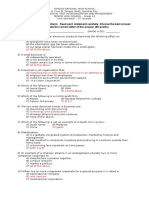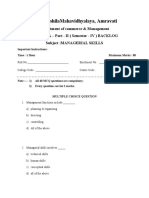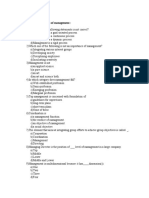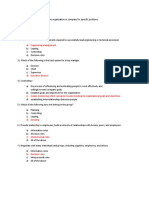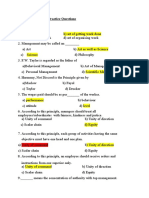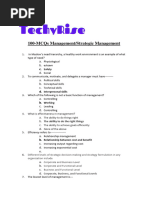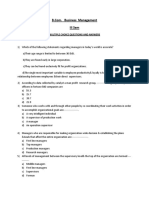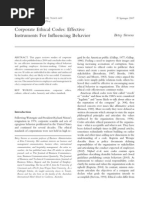0 ratings0% found this document useful (0 votes)
23 viewsMCQ's
MCQ's
Uploaded by
drambreenkhurramThe document appears to be a midterm exam for a course on management. It contains 43 multiple choice questions testing concepts related to management functions, decision making processes, organizational plans and environmental factors. The exam covers a wide range of management topics and seems to assess students' understanding of fundamental principles.
Copyright:
© All Rights Reserved
Available Formats
Download as DOCX, PDF, TXT or read online from Scribd
MCQ's
MCQ's
Uploaded by
drambreenkhurram0 ratings0% found this document useful (0 votes)
23 views7 pagesThe document appears to be a midterm exam for a course on management. It contains 43 multiple choice questions testing concepts related to management functions, decision making processes, organizational plans and environmental factors. The exam covers a wide range of management topics and seems to assess students' understanding of fundamental principles.
Copyright
© © All Rights Reserved
Available Formats
DOCX, PDF, TXT or read online from Scribd
Share this document
Did you find this document useful?
Is this content inappropriate?
The document appears to be a midterm exam for a course on management. It contains 43 multiple choice questions testing concepts related to management functions, decision making processes, organizational plans and environmental factors. The exam covers a wide range of management topics and seems to assess students' understanding of fundamental principles.
Copyright:
© All Rights Reserved
Available Formats
Download as DOCX, PDF, TXT or read online from Scribd
Download as docx, pdf, or txt
0 ratings0% found this document useful (0 votes)
23 views7 pagesMCQ's
MCQ's
Uploaded by
drambreenkhurramThe document appears to be a midterm exam for a course on management. It contains 43 multiple choice questions testing concepts related to management functions, decision making processes, organizational plans and environmental factors. The exam covers a wide range of management topics and seems to assess students' understanding of fundamental principles.
Copyright:
© All Rights Reserved
Available Formats
Download as DOCX, PDF, TXT or read online from Scribd
Download as docx, pdf, or txt
You are on page 1of 7
Roll No.
National University of Modern Languages
IBF Campus - Lahore
Midterm Examination – March 2014
Course: Program:
Instructor: Semester: Morning/Evening
Instructions:
Maximum marks: 30
Time allowed 1.5 hour (90 Minutes)
All questions carry equal marks (or as the case may be)
Question # 1 (Marks: 15)
(Part A: Objective)
Encircle the right option:
1. When we classify managers according to their level in the organization they are
described as:
a) Functional, staff and line managers
b) Top managers, middle managers and supervisors
c) High level and lower level managers
d) General managers and administrative managers
2. __________ is NOT one of the eight steps in the decision making process.
a) Identifying the problem
b) Analyzing alternative solutions
c) Implementing the decision
d) Delegating the decision making
3. ____ plans have clearly defined objectives.
a) Directional
b) Flexible
c) Specific
d) Standing
4. The resources within an organization, used to achieve its goal, make up
the______ of a business.
a) External environment
b) Internal environment
c) Social responsibility
d) Workers motivation
5. __________ is the process of using the resources and personnel of an
organization in an orderly way to achieve the objectives and long-term goals of
the organization.
a) Planning
b) Organizing
c) Leading
d) Controlling
6. ------------- roles involve people and other duties that are ceremonial and
symbolic in nature.
a) Informational.
b) Interpersonal.
c) Decisional
d) All of the given options.
7. Getting work done with a minimum of effort, expense or waste is the definition
of:
a) Effectiveness.
b) Management
c) Planning.
d) Efficiency
8. Managers having the least authority and are at the lowest level in the hierarchy
of the organization are called:
a) Middle level managers
b) Top level managers
c) First-line managers
d) None of the given options
9. ____________ reduces uncertainty
a) Negotiating
b) Planning
c) Organizing
d) Leading
10. ----------- maintains self-developed network of outside contacts and informers
who provide favors and information.
a) Entrepreneur
b) Monitor
c) Liaison
d) Figurehead
a) alse
11. Managers with titles such as regional manager, project leader, or plant
manager are:
a) first-line managers
b) top managers
c) production managers
d) middle managers
12. Writing an organizational strategic plan is an example of which management
function:
a) leading
b) coordinating
c) planning
d) organizing
13. The process of monitoring, comparing, and correcting is called:
a) controlling
b) coordinating
c) leading
d) organizing
14. Which of the following is NOT an example of a decisional role according to
Mintzberg?
a) spokesperson
b) entrepreneur
c) disturbance handler
d) resource allocator
15. Understanding building codes would be considered a ________ skill for a
building contractor.
a) human
b) technical
c) conceptual
d) empirical
16. Which of the following is true concerning technical and managerial skills?
a) Human skills and technical skills remain equally important as managers move to
higher levels.
b) Technical-skill needs remain necessary and human skills decrease as managers
move to higher levels.
c) Human skills remain necessary and technical-skill needs decrease as managers
move to higher levels.
d) Both human-skill and technical-skill needs decrease as managers move to higher
levels.
17. Managers with good ________ are able to communicate, motivate and lead to
get the best out of their people.
a) human skills
b) conceptual skills
c) technical skills
d) visual skills
18. An organization is ________.
a) the physical location where people work
b) a collection of individuals working for the same company
c) a deliberate arrangement of people to accomplish some specific purpose
d) a group of individuals focused on profit making for their shareholders
19. Interest rates, inflation rates, and stock market fluctuations are all examples of
what factor in an organization's general environment?
a) economic
b) political
c) social
d) technological
20. ________ is the existence of a discrepancy between an existing and a desired
state of affairs.
a) An opportunity
b) A solution
c) A weakness
d) A problem
21. What is the second step in the decision-making process?
a) identifying decision criteria
b) allocating weights to the criteria
c) analyzing alternatives
d) identifying a problem
22. Nonprogrammed decisions are best described as ________.
a) recurring, but difficult to make
b) very similar to problems in other areas of the organization
c) requiring more aggressive action on the decision maker's thought processes
d) unique and nonrecurring
23. Lower-level managers typically confront what type of decision making?
a) unique
b) non-routine
c) programmed
d) non-programmed
24. Which of the following is likely to make the most programmed decisions?
a) the CEO of PepsiCo
b) the vice president of General Motors Cadillac Division
c) the head of the Minute Maid Division at Coca-Cola
d) the manager of the local McDonald's
25. The most common ways to describe organizational plans are by their
frequency of use, time frame, specificity, and:
a) Quantifiability
b) flexibility
c) breadth
d) attainability
26. Directional plans ________.
a) have clearly defined objectives
b) identify general guidelines
c) meet the needs of a unique situation
d) last for 3-5 years
27. ________ is a one-time plan specifically designed to meet the needs of a unique
situation.
a) A multipurpose plan
b) A strategic plan
c) An operational plan
d) A single-use plan
28. What is the purpose of an organization called?
a) the organization's action plan
b) the organization's mission
c) the organization's vision
d) the organization's contingency plan
29. A general guideline for making a decision about a structured problem is called:
a) Rule
b) Policy
c) Procedure
d) None of above
30. Which of the following related to the a company stakeholder’s group:
a) Competitors
b) Governments
c) Media
d) All of above
31. A situation in which manager can make an accurate decision is called:
a) Certainty
b) Uncertainty
c) Risk
d) Factual
32. The customs, mores, values and demographic characteristics of the society in
which the organization function are called:
a) The socio-cultural element
b) The legal-political element
c) The economic element
d) The international element
33. NASA shoots a rocket and then continuously observes and makes whatever
course corrections are needed to keep it on track. This process is called:
a) Planning
b) Organizing
c) Leading
d) Controlling
34. Which type of managerial skill refers to the ability to analyze and diagnose
complex situations?
a) Problem-solving
b) Interpersonal
c) Conceptual
d) Technical
35. Munib is the CEO of a hospital. He has spent his day planning the schedules of
employees for next month. He spent his day in:
a) Planning
b) Organizing
c) Leading
d) Controlling
36. Jamshed is the CFO at Mutual Saving Bank. According to research studies,
which management activities are likely to take up the greatest amount of his
time?
a) Planning
b) Organizing
c) Controlling
d) Leading
37. Asim assigns Khalid a project to be completed by the end of the month and then
holds periodic meetings with him to review his progress. Which of the
management function Asim is performing?
a) Controlling
b) Organizing
c) Planning
d) Leading
38. All of the following are the Characteristics of an organization. EXCEPT:
a) People
b) Product
c) Purpose
d) Structure
39. When an organization encounters a serious problem which needs to be solved
immediately, it is called:
a) Crisis problem
b) Non- Crisis problem
c) Opportunity problem
d) Financial Problem
40. Plans which have the broadest organizational focus and the longest time frame
are called:
a) Tactical
b) Strategic
c) Directional
d) Operational
41. When an organization encounters an issue that requires resolution, but not very
immediate action, it is called:
a) Crisis problem
b) Non- Crisis problem
c) Opportunity problem
d) Financial Problem
42. Which of the following related to the a company stakeholder’s group:
e) Competitors
f) Governments
g) Media
h) All of above
43. Asim assigned Khalid a project to be completed by the end of the month and
then hold periodic meetings with him to review his progress and guide him
according to his requirements. Which management function Asim is
performing?
a) Planning
b) Leading
c) Controlling
d) Organizing
44. At which level/levels may an organization’s goals and plans exist.
a) Strategic
b) Tactical
c) Operational
d) All of above
45. Which of these is/are responsible for operational goals/plans.
a) Middle management
b) Board of directors
c) First-line management
d) None of above
(Part B) Marks (12)
Answer these questions briefly.
Q#1: How many types of managerial skills are there and how do the managers apply them at
different levels of management?(4)
Q#2: Write down the steps of decision-making process.(4)
(Part C) Marks (3)
Situation # 1
EFFICIENT DECISION MAKING
Once there lived a rich man, who had three sons. He died at his old age, leaving
behind 17 cows for his three sons. In the legal heir, he mentioned that 1/2 of 17 cows
go to his eldest son. One sixth of total cows go to his second son and 1/9 of all cows
to his youngest one. Every one must give a cow to the person who divides the cows to
all three without any disputes and conflicts.
By reading the heir, everyone was confused. The villagers came to the conclusion that
at least one of them must adjust, otherwise, it is impossible. But none of the brothers
is willing to sacrifice their part. Everyone was expecting that this would end up with a
quarrel.
At this occasion, there came another traveler, with a cow. He asked the entire story
and happening. He assured that he would solve the problem, if the villagers and the
brothers are willing to.
Define how that villager will solve this problem
Good Luck
You might also like
- Impact of Human Factors On Interprofessional Collaboration and Service User Safety.Document12 pagesImpact of Human Factors On Interprofessional Collaboration and Service User Safety.Brymak Bryant100% (1)
- Principles of Management MCQS With Answers of Stephen PDocument21 pagesPrinciples of Management MCQS With Answers of Stephen Psridharpalleda72% (76)
- Assessment Task 1 - BSBSTR502 V1.1Document9 pagesAssessment Task 1 - BSBSTR502 V1.1ZomakSoluionNo ratings yet
- Organization and Management Quarterly ExamDocument4 pagesOrganization and Management Quarterly ExamLee Dumalaga Carinan93% (15)
- Part 2 MGMT Exit Exam Worksheet QuestionDocument26 pagesPart 2 MGMT Exit Exam Worksheet QuestionTigabu Tegene93% (30)
- Public Awareness and The Environment "How Do We Encourage Environmentally Responsible Behaviour"Document8 pagesPublic Awareness and The Environment "How Do We Encourage Environmentally Responsible Behaviour"SITI NUR NADIA AHMAD SHUKRINo ratings yet
- Unit 7 Sociology Decisions, DecisionsDocument47 pagesUnit 7 Sociology Decisions, DecisionsChristina Fington0% (1)
- Managerial SkillsDocument12 pagesManagerial SkillsRaghuNo ratings yet
- Em Isa-1 Qp-26 Feb 2023Document4 pagesEm Isa-1 Qp-26 Feb 2023syedasabah08No ratings yet
- Unit 1: Nature & Functions of ManagementDocument13 pagesUnit 1: Nature & Functions of ManagementKiran J100% (1)
- Mop QCMDocument21 pagesMop QCMSanjay BabujiNo ratings yet
- MAN - CH - 2 - MCQsDocument6 pagesMAN - CH - 2 - MCQsSaquibh ShaikhNo ratings yet
- Principles of Management MCQS With Answers of Stephen PDocument19 pagesPrinciples of Management MCQS With Answers of Stephen PAfreen ReignNo ratings yet
- Principles of ManagementDocument9 pagesPrinciples of Managementkingappu8888No ratings yet
- Management Question Bank CT-1 (2023-24) SolutionDocument6 pagesManagement Question Bank CT-1 (2023-24) SolutionBhakti ShingadiNo ratings yet
- Chap 12 PM-BB Multiple Choice Type QuestionsDocument24 pagesChap 12 PM-BB Multiple Choice Type QuestionspuneetNo ratings yet
- Management I: Instructions: Circle The Correct Answer For Each Question (1 Mark Each)Document5 pagesManagement I: Instructions: Circle The Correct Answer For Each Question (1 Mark Each)AsheNo ratings yet
- CH 11Document6 pagesCH 11أبو الحسن المطريNo ratings yet
- Man QBDocument5 pagesMan QBΨⱠ̶υ̶ƈ̶ƙ̶y̶ΨNo ratings yet
- Fundamentals of Management For For III Yr ObjectiveDocument10 pagesFundamentals of Management For For III Yr ObjectivePrince PrashanthNo ratings yet
- Principles of Management Mcqs With Answers of Stephen PDocument25 pagesPrinciples of Management Mcqs With Answers of Stephen PItrat Abbas100% (2)
- Q For PPMDocument11 pagesQ For PPMChicharito El MaravillaNo ratings yet
- Questions For Engineering ManagementDocument6 pagesQuestions For Engineering ManagementJoshua SilotNo ratings yet
- 1818 Hardik Raut - MCQ PracticeDocument5 pages1818 Hardik Raut - MCQ PracticeMicrosoft RewardNo ratings yet
- Introduction To Management - Revision - Riham SabryDocument185 pagesIntroduction To Management - Revision - Riham Sabrymaryamelghrbawy316No ratings yet
- MPE - Question Bank First UnitDocument6 pagesMPE - Question Bank First UnitMAYUR BHOSALENo ratings yet
- Chapter 1 4 ExamDocument12 pagesChapter 1 4 ExamDrogNo ratings yet
- Chapter 1Document23 pagesChapter 1MeaadNo ratings yet
- ch1 QuizDocument10 pagesch1 QuizBhavika GholapNo ratings yet
- Question BankDocument25 pagesQuestion BankheretosavefortniteNo ratings yet
- Question Bank MANDocument5 pagesQuestion Bank MANxlilysamikshaoswalNo ratings yet
- MPOB MCQsDocument15 pagesMPOB MCQsUdit SinghalNo ratings yet
- Strategic Management: 2 Quiz Roll No.Document5 pagesStrategic Management: 2 Quiz Roll No.Hira Raza100% (1)
- ch1 QuizDocument10 pagesch1 QuizKumar KrNo ratings yet
- Team Building & Leadership MCQs 30Document5 pagesTeam Building & Leadership MCQs 30singhaliti100% (4)
- BBPP1203Document4 pagesBBPP1203MarulNo ratings yet
- 1st Quiz - Feb 24, 2021Document4 pages1st Quiz - Feb 24, 2021Hira RazaNo ratings yet
- MCQ Man Unit 1Document6 pagesMCQ Man Unit 1MA TechnicalNo ratings yet
- QB PPMDocument13 pagesQB PPMnikhilcharmingNo ratings yet
- 100 MCQs Management 1 AutoRecovered 1Document15 pages100 MCQs Management 1 AutoRecovered 1hamzaali5973No ratings yet
- Principle of Management Mcq-1Document19 pagesPrinciple of Management Mcq-1piechart74411No ratings yet
- Man-Mcq Unit-IiDocument4 pagesMan-Mcq Unit-Iiabhaykurkute44No ratings yet
- PPM1Document25 pagesPPM1diveshpoojary2000No ratings yet
- OM First Periodical TestDocument5 pagesOM First Periodical TestWilma DoradoNo ratings yet
- Bus 102 Emag Questions and AnswersDocument6 pagesBus 102 Emag Questions and Answersifeomajenny2004No ratings yet
- Past QuestionsDocument12 pagesPast QuestionsKOFI BROWNNo ratings yet
- Om 1ST QuaDocument3 pagesOm 1ST Quamaricar jodelah uyegNo ratings yet
- Chapter 2 Review Quiz RevisedDocument7 pagesChapter 2 Review Quiz RevisedHai Ha NguyenNo ratings yet
- Interview Questions and Answers For Industrial Engineering Job in Apparel IndustryDocument8 pagesInterview Questions and Answers For Industrial Engineering Job in Apparel IndustryIshtiakNo ratings yet
- Test 1Document4 pagesTest 1Satish VarmaNo ratings yet
- Chapter 1Document13 pagesChapter 1ngoc61994No ratings yet
- Question Bank For MANDocument5 pagesQuestion Bank For MANShravan gujarNo ratings yet
- Principles of Management ReviewDocument23 pagesPrinciples of Management ReviewThanh Nguyen VanNo ratings yet
- MOB-II-2024Document2 pagesMOB-II-2024G Usha 140No ratings yet
- Pinto pm5 Tif 02Document24 pagesPinto pm5 Tif 02Salem BawazirNo ratings yet
- Chapter 1 QuestionsDocument10 pagesChapter 1 QuestionsrawezhcpmNo ratings yet
- Management Quiz1 AnswersDocument4 pagesManagement Quiz1 AnswersMazen HNo ratings yet
- III SEM - Business ManagementDocument25 pagesIII SEM - Business Managementyashika swamiNo ratings yet
- MGT402 midterm preparation fileDocument18 pagesMGT402 midterm preparation fileaw440pakiboyNo ratings yet
- Question Paper - Final Examination - Introduction To BusinessDocument13 pagesQuestion Paper - Final Examination - Introduction To BusinessKavitha SubramaniamNo ratings yet
- MGT 2010 Sem 2 15-16 PDFDocument12 pagesMGT 2010 Sem 2 15-16 PDFsapik zirafNo ratings yet
- Quiz 1 (All)Document6 pagesQuiz 1 (All)Anh Nghia MaiNo ratings yet
- DesignAdvisor v4 User GuideDocument54 pagesDesignAdvisor v4 User GuideHAHS DoshiNo ratings yet
- Possible Harms of Artificial Intelligence and The EU AI Act Fundamental Rights and RiskDocument15 pagesPossible Harms of Artificial Intelligence and The EU AI Act Fundamental Rights and Riskdarkleaf03No ratings yet
- Ethics Section - Chapter 6 - Principles of Engineering EthicsDocument3 pagesEthics Section - Chapter 6 - Principles of Engineering EthicsMohammad Haseeb ButtNo ratings yet
- Pharma Medical Affairs 2020 and BeyondDocument14 pagesPharma Medical Affairs 2020 and BeyondlilicpNo ratings yet
- de Bruijn Ten Heuvelhof Chapter 3Document25 pagesde Bruijn Ten Heuvelhof Chapter 3iardenakuznetchNo ratings yet
- Marketing Management (Chapter 7)Document26 pagesMarketing Management (Chapter 7)Hamidul IslamNo ratings yet
- Corporate Ethical Codes: Effective Instruments For Influencing BehaviorDocument10 pagesCorporate Ethical Codes: Effective Instruments For Influencing Behaviorkkb410No ratings yet
- Module 2Document8 pagesModule 2prakharchawla9975No ratings yet
- Universal Human Value NotesDocument113 pagesUniversal Human Value NotesHari PrasathNo ratings yet
- Business Ethics: The Law of RulesDocument35 pagesBusiness Ethics: The Law of RulesShivaniRahejaNo ratings yet
- Global Business Simulation Course Outline 2024Document4 pagesGlobal Business Simulation Course Outline 2024ipm02ananyajNo ratings yet
- Document 4Document4 pagesDocument 4faithkharyljoyNo ratings yet
- Incremental Analysis Basic ConceptsDocument47 pagesIncremental Analysis Basic ConceptsWinter SummerNo ratings yet
- 1993 - Strategic Sensemaking and Organizational Performance Linkages Among Scanning, Interpretation, Action, and OutcomesDocument33 pages1993 - Strategic Sensemaking and Organizational Performance Linkages Among Scanning, Interpretation, Action, and OutcomestiagocriciumaNo ratings yet
- Auto Neighbor Group Configuration (ERAN15.1 - 01)Document42 pagesAuto Neighbor Group Configuration (ERAN15.1 - 01)waelq2003No ratings yet
- Organizational Behaviour Syllabus PDFDocument6 pagesOrganizational Behaviour Syllabus PDFAmorsolo EspirituNo ratings yet
- BestPractice ExamDocument8 pagesBestPractice ExamMENDOZA JUDY ANNNo ratings yet
- Principles of Management ReviewDocument23 pagesPrinciples of Management ReviewThanh Nguyen VanNo ratings yet
- Managerial Economics - EssayDocument5 pagesManagerial Economics - EssayJohn JosephNo ratings yet
- Major Sales Strategy-JayeshDocument13 pagesMajor Sales Strategy-JayeshjayeshNo ratings yet
- Ch3 Consumer & Organizational Buyer BehavourDocument34 pagesCh3 Consumer & Organizational Buyer BehavourJaehyun PeachNo ratings yet
- Conflict ManagementDocument10 pagesConflict ManagementAnk SevenNo ratings yet
- Vacancy: Financial Accountant (D)Document1 pageVacancy: Financial Accountant (D)Moses Nhlanhla MasekoNo ratings yet
- Function of Management: Jahid Hasan Assistant Professor Department of IPE, SUSTDocument54 pagesFunction of Management: Jahid Hasan Assistant Professor Department of IPE, SUSTফারহান আহমেদ আবীরNo ratings yet
- Engineering Materials Answer KeyDocument4 pagesEngineering Materials Answer KeyCosmic DragonNo ratings yet
- Data Center AssessmentsDocument12 pagesData Center Assessmentsyadav123456100% (1)



